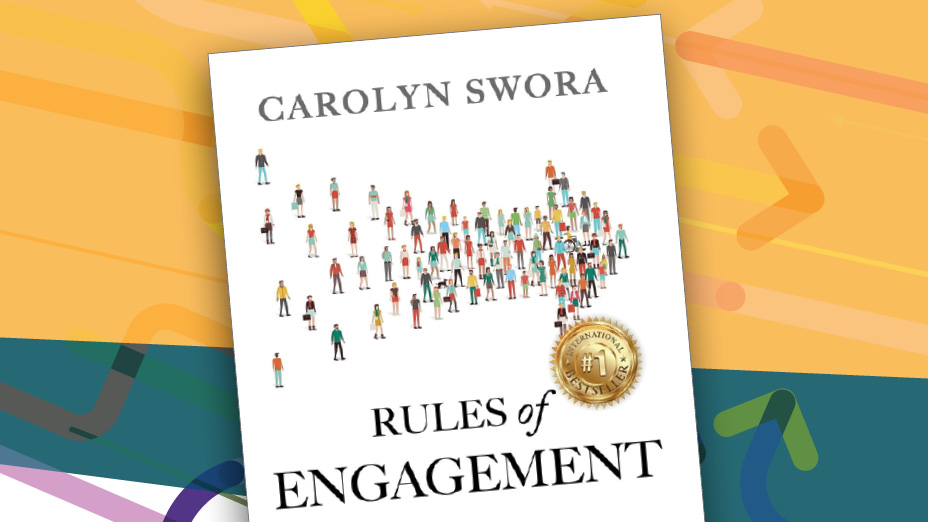Summary written by Sara Saddington
The Big Idea
"Organizations were forced by circumstance to focus on consistency and process, but in the process, they have lost sight of the impact it has on people. You need to connect to people not process and allow yourself to be human because you can only connect when you’re being authentic—as one authentic human being to another." - RULES OF ENGAGEMENT, PAGE 131
In her first book, Rules of Engagement: Building a Workplace Culture to Thrive in an Uncertain World, Carolyn Swora achieves a feat rare for even the most seasoned authors—she masterfully blends deeply personal story-telling with highly practical advice. I read this book in an afternoon—it jumped off the page and grabbed me (with apologies to all the work I ignored that day). Swora writes elegantly, with plenty of research and personal examples, about the challenges that all of us are currently facing at work. Change is constant. Our brains are wired to view change as a threat—and when our brains go into threat response mode, we shut down our capacity for creative problem solving. Swora offers an alternative: by creating more human workplaces we can build more resilient organizations.
Rules of Engagement is a fantastic read, full of truly actionable insights. Swora does a masterful job of balancing the highly practical with the deeply personal. For anyone who leads or is a part of a team, this book is essential reading. Our current system—focusing on processes instead of people, expecting teams to do more with less without ever acknowledging the human toll that takes, an industrial era obsession with productivity—is broken. By understanding and embracing the Rules of Engagement, we can all have happier, healthier, more engaging experiences at work. Change is coming for us all. How we handle it will be a differentiating factor between the organizations that thrive, and those that get left behind.
INSIGHT #1 THE TRUST BOUNDARY
Swora uses the metaphor of an iceberg to describe organizational culture. Above the “waterline” where the iceberg is visible, are things like results, behaviors, and processes. Below the waterline,” or the part of the iceberg that can’t be seen, are things like beliefs and values, identity, and purpose. The threshold which indicated the difference between the seen and unseen is called the Trust Boundary.
However, the Trust Boundary is not fixed. Organizations that suffer from low-trust cultures will certainly be limited in what they can observe. But organizations with high trust are able to create increased visibility into things that usually remain hidden.
Just about every organization has a values statement. Most of them languish in the company handbook in a drawer somewhere, or are written on the boardroom wall, mostly forgotten. In those cases, the values that drive employees are hidden, not likely to align with the values the company aspires to. At Actionable, our values are front and center: at our monthly town hall, we start with 10 minutes of shout outs to team members who have lived our values. And I don’t think it’s a coincidence that our work environment comes with a high degree of trust and authenticity—I feel like I can bring my whole self to work with me everyday.
In these VUCA times, trust is essential. It’s a lot easier to take a leap when you know that there’s a safety net in place. Knowing that you have a team in place that will help you expand your thinking means that you have the freedom to be creative and flexible—which is exactly what your organization needs to stay agile in times of rapid change.
INSIGHT #2 HONOR THE PSYCHOLOGICAL CONTRACT
The psychological contract is a lot like organizational culture—hard to pin down, even harder to change, and yet present in every interaction. An employee who is used to feeling that their ideas are valued will have a hard time adjusting to a new manager who shoots down new ideas. An individual who is used to working from home a few days a week will not be pleased to learn that they have to be onsite 9-5 everyday after a change in policy.
Change is inevitable. When VUCA hits, teams need happy, engaged employees to thrive. Just be careful that you respect the psychological contract while you’re managing change. Have a look at the makeup of your team, and make a list of the “unwritten” rules of your workplace. Some of those norms may need to be adjusted as you tackle the difficulties of change—just be careful to go slow, and be aware of the impact on employees. The day you ask everyone to put in some extra hours for a big project is not a great day to change your remote working policy. And the few weeks it will take to get used to a new process or piece of software are not the same weeks you should be radically changing your meeting structure.
The Four Rules of Engagement
Many organizations have been built using industrial models for productivity, and outdated thoughts about how to structure teams and hierarchies. Ironically, these systems focus almost exclusively on results—meeting targets, improving efficiency, and doing more with less. However, in our VUCA world (volatile, uncertain, complex, ambiguous), this focus on process over people creates ineffective workplace cultures, employee burnout, and sagging engagement—which in turn effects results.
Swora identifies four “Rules of Engagement” to help organizations learn to focus on the people—not the process—that will drive them to success in our current business landscape, and create a Purposeful Work Experience™.
- The Rule of Connection Instead of focusing on metrics, efficiency, or productivity, leaders should focus on purpose, identity, beliefs, and values—for the organization as a whole, and for the individuals who work within it. We all want to feel that we belong. And individuals who feel that they belong are more likely to show up enthusiastically and authentically—and create better results in the process.
- The Rule of Collaboration People are far more likely to respond to change in an effective way if they have been involved in the decision making process. They are also more likely to be effective and authentic when ideas have been generated in an environment that encourages a diversity of thought.
- The Rule of Adaptability The ability to deviate from a tactical plan helps to differentiate between organizations that thrive, and those that become cautionary tales (Blockbuster, anyone?). Something is going to go wrong. It’s just a matter of what (and when)—so being willing and ready to change tactics in the moment, while staying true to your overall strategy, is a competitive advantage.
- The Rule of Equivalence Typically, organizations give a lot of attention to senior leaders. The higher up the org chart, the more learning and development invested, the more authority, the more gravitas. But VUCA isn’t a management issue, it’s an everyone issue. Everyone can be a leader if you treat them equally.





.png)



What Did You Think?